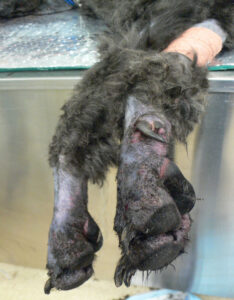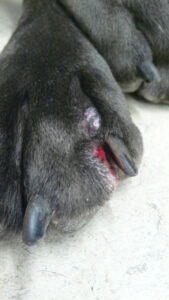Why should I bring my pet to Willows for Pododermatitis?
Willows is one of Europe’s leading small animal referral centres. Our state-of-the-art hospital is led by internationally renowned Specialists who are committed to providing the highest standards of veterinary care.
The Dermatology service at Willows is led by Dr Richard Harvey BVSc DVD DipECVD PhD FRSB FRCVS, who is very experienced in managing patients with pododermatitis.
What is Pododermatitis?
Pododermatitis is a term used to describe inflammation affecting the skin of the feet. It often causes dogs to have swollen, red and itchy feet, which can progress to painful sores. In very severe cases, dogs can even become lame. This is a relatively common skin problem in dogs and can be present on its own, or as part of a more widespread skin problem. There are many causes of pododermatitis, and in some patients, more than one cause is present at the same time. It is important to obtain an accurate diagnosis to ensure that the right treatment can be selected.
How is Pododermatitis Diagnosed?
The diagnosis of pododermatitis can often be achieved following a thorough evaluation of the history and clinical signs. Hair plucks and skin scrapings are often performed to diagnosis Demodex mite infestation, and swab samples are often taken to establish if an infection is present. If the clinical picture is very suggestive of a foreign body, X-rays may be needed along with a surgical procedure to remove the offending item. Conformational pododermatitis is usually diagnosed by examining the feet and assessing the shape (conformation) of the footpads.
What Causes Pododermatitis?
The parasitic mite Demodex can infect the haired skin of the feet and result in pododermatitis. Demodex mites are present in very low numbers in the skin of all dogs, but in some patients, either due to a genetic susceptibility, or due to a process that lowers the immune system, these mites can populate the skin in very large numbers causing disease (Fig 1.).
Figure 1: A case of pododermatitis due to Demodex mites (feet have been clipped for cleaning).

What are the Treatments Available?
Treatments for pododermatitis vary depending on the underlying cause. Parasitic infestations are usually treated with tablets or dips/rinses for the feet. Deep infections are often treated with long courses of antibiotics. Foreign bodies are best treated by identifying the foreign body and removing it in a minor surgical procedure. Conformational pododermatitis is perhaps the most difficult to treat, as the defect is due to the shape of the feet. Many of these cases can only be managed, and require modifications such as protective boots, foot washing and avoidance of rough/uneven terrain. In the very worst cases, conformational pododermatitis can be corrected with surgery to fuse the toe webs together.
What Can I Expect if my Pet has been Diagnosed with Pododermatitis?
As there are numerous causes of pododermatitis, and more than one can be present at the same time, a good prognosis depends on identifying all the contributing factors and correcting them if possible. If this can be done, the vast majority of cases will have a good outcome. Cases of conformational pododermatitis are rarely cured and require long term management.
To save this page as a PDF, click the button and make sure “Save as PDF” is selected.
Skin and Ear Clinic
Find out more
To assist owners whose pets have skin and ear conditions, we have put together a range of information pages to talk you through some of the more common dermatology conditions seen by our Specialist team.


